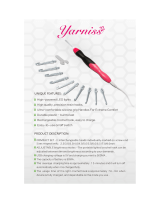
Utilisation et soins de l'outil
mécanique
1) Ne forcez pas l'outil mécanique. Utili-
sez l’outil mécanique correct pour votre
application.
L’outil mécanique correct exécute mieux le tra-
vail dans de meilleurs conditions de sécurité s’il
est utilisé à l’allure pour laquelle il a été conçu.
2) N'utilisez pas l'outil mécanique si l’inter-
rupteur ne le met pas en marche ou ne
l’arrête pas.
Tout outil mécanique qui ne peut pas être
contrôlé par son interrupteur est dange
-
reux et doit être réparé.
3) Débranchez le cordon d’alimentation de
la prise secteur et/ou la batterie autono
-
me de l’outil mécanique avant d’effectuer
des réglages, de changer des accessoi
-
res ou de ranger les outils électriques.
De telles mesures de sécurité préventives
réduisent les risques de faire démarrer
l’outil mécanique accidentellement.
4) Rangez les outils mécaniques inutilisés
hors de la portée des enfants et ne laissez
personne qui n’est pas familiarisé avec
l’outil mécanique ou ses instructions faire
fonctionner l’outil mécanique.
Les outils mécaniques sont dangereux
dans les mains des utilisateurs manquant
d’entraînement.
5) Entretenez bien les outils mécaniques.
Vérifiez l’alignement ou l’emboîtage des
pièces en mouvement, l’intégrité des piè
-
ces et toute autre condition pouvant affec
-
ter le fonctionnement de l’outil mécanique.
S’il est endommagé, faites réparer l’outil
mécanique avant de l’utiliser.
De nombreux accidents sont provoqués
par des outils mécaniques mal entretenus.
6) Maintenez les outils de coupe affûtés et
propres.
Les outils de coupe bien entretenus avec des
lames bien affûtées ont moins de chances de
gripper et sont plus faciles à contrôler.
7) Utilisez l'outil mécanique, les acces-
soires, les mèches, etc., conformément
à ces instructions et de la façon pour
laquelle l’outil particulier a été conçu
en tenant compte des conditions de
travail et de la tâche à exécuter.
L’utilisation de l’outil mécanique à des fins
autres que celles pour lesquelles il a été
conçu peut présenter une situation à risque.
Utilisation et entretien de l'outil
à batterie
1) Avant d'insérer la batterie autonome,
assurez-vous que l’interrupteur d’alimen
-
tation est bien sur la position d’arrêt.
Si vous insérez la batterie autonome dans
des outils électriques dont l’interrupteur d’ali-
mentation est sur la position de marche,
vous risquerez de causer un accident.
2) Effectuez la recharge en utilisant unique-
ment le chargeur spécifié par le fabricant.
Un chargeur convenant à un certain type de
batterie autonome risque de causer un incen
-
die s’il est utilisé avec un autre type de bloc-
batterie.
3) Utilisez les outils électriques unique-
ment avec les batteries autonomes
indiquées spécifiquement.
Si vous utilisez d’autres types de batterie
autonome, vous risquez de vous blesser
ou de causer un incendie.
4) Lorsque vous n'utilisez pas la batte-
rie autonome, gardez-la à distance des
objets métalliques tels que des trombo
-
nes, des pièces de monnaie, des clés, des
clous, des vis et des autres petits objets
métalliques risquant d’établir une con
-
nexion entre les bornes de la batterie.
Si les bornes de la batterie sont court-cir
-
cuitées, vous risquerez de vous brûler ou
de causer un incendie.
5)
En cas de manipulation brutale, de l'électro-
lyte risque d’être éjecté de la batterie; évitez
tout contact avec l’électrolyte. Si un contact
accidentel se produit avec l’électrolyte, rin-
cez abondamment avec de l’eau. Si l’électro
-
lyte entre en contact avec les yeux, consultez
immédiatement un médecin.
L’électrolyte éjecté de la batterie risque de
causer des irritations ou des brûlures.
Réparation
1) Faites réparer votre outil mécanique
par du personnel de réparation qualifié
en n'utilisant que des pièces de rechan
-
ge identiques.
Ceci assure le maintien de la sécurité de
l’outil mécanique.
AVERTISSEMENT
Pour éviter de se blesser, l’utilisateur
doit lire la notice d’utilisation.
II. RÈGLES DE SÉCU-
RITÉ SPÉCIALES
1) Tenez l'outil par les surfaces de prise iso-
lées lorsque vous effectuez une opération
lors de laquelle l’outil de coupe risque d’en
-
trer en contact avec des câblages cachés.
Le contact avec un fil sous tension fera
passer le courant dans les pièces métalli
-




















